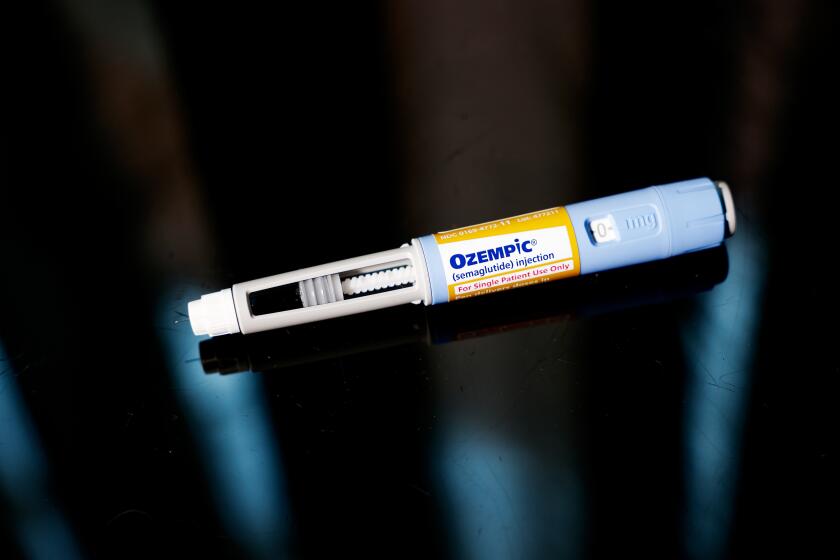Opinion: I’m a doctor in East L.A. and Beverly Hills. I want to treat obesity the same way in both places

As a diabetes specialist, I’ve treated thousands of patients, some in Beverly Hills and some in East Los Angeles. My Beverly Hills patients live to become healthy 80- and 90-year-olds. I can’t remember when my last patient from this community lost their vision, had an amputation or started dialysis. Almost none have heart attacks or strokes.
But in under-resourced parts of East L.A. I see people every week in their 40s and 50s who have developed life-altering, preventable diabetes complications — blindness, kidney failure, the loss of a limb. These patients rarely live to grow old.
Obesity is one of the drivers of this heartbreaking disparity. Health-conscious Beverly Hills is replete with doctors’ offices, fresh food and gyms. Most residents there can spend what they need to maintain a healthy diet and get help to control diabetes. In East Los Angeles, where for some a home refrigerator can be a luxury, diabetes and obesity afflict thousands of families who depend on fast and processed food to provide the affordable calories they need to survive.
L.A. is particularly susceptible to “miracle” cures. And there are some troubling aspects of the Ozempic gold rush that don’t get enough attention.
The tale of these two neighborhoods is replicated across the country. Obesity kills 300,000 Americans annually. It is associated with increased risk of more than 200 other diseases, including heart disease, diabetes, cancer and dementia. According to modeling by my colleagues at the USC Schaeffer Institute for Public Policy & Government Service, the average American will soon have obesity. Black and Latino individuals experience higher rates of severe obesity compared to non-Latino white people, translating into higher rates of chronic diseases.
Despite decades of public health efforts, obesity increases. Some recent lifestyle interventions have shown promise; for the most part, however, simply urging people in minority neighborhoods to change their diets has proved ineffective. Although providing resources and education do help, these initiatives are often grant-funded and not routinely available. Lots of proposed solutions that might resonate in wealthier communities, such as recommending “fixed” foods, with reduced sugar, fats and preservatives, just don’t fly in East L.A. Cost and availability of healthy foods are two reasons. So is culture. Where there is food insecurity, familiar food can be a celebration not easily surrendered.
As consumers seeking to lose weight face Ozempic shortages, many are turning to a booming, less regulated market for compounded versions of the drug.
But at least one weight-loss remedy that is enormously popular in Beverly Hills also works across town: medication. New drugs such as Wegovy/Ozempic (semaglutide) and Zepbound/Mounjaro (tirzepatide), if used with proper medical supervision, can often reduce body weight by 15% or more. Several of my patients with severe obesity have lost close to 100 pounds and avoided much more burdensome metabolic surgery.
The drugs come with list prices that can top $1,200 a month, although health insurance companies often negotiate deep discounts. So far Medicare is not helping reduce patient costs because it is barred from paying for weight-loss drugs. But Medicaid, the state/federal program that covers the poor, faces no such constraint. And it has a big price advantage: By law, it automatically gets the biggest discounts negotiated by any payer.
Several states, including California, have added one or more of the obesity drugs to their Medicaid formularies. In Los Angeles County, use is still not widespread as doctors have to secure prior authorizations through Medicaid managed-care organizations and teach patients how to inject themselves at home. But among those patients who are taking the drugs, we are seeing improvements in health.
Providing GLP-1 drugs to 19.7 million Medicare beneficiaries with obesity would cost $268 billion a year, researchers estimate in a recent study.
The balance between the drugs’ prices and their benefits is a fraught debate, mostly centered on what would happen to public and private sector budgets under broadened coverage. The Congressional Budget Office recently concluded that the costs of authorizing coverage in Medicare would exceed the benefits of beneficiaries’ improved health for the next 10 years.
I’m not an economist, but I know that focusing just on government ledgers can be shortsighted. I see firsthand that medications have a big role to play in the treatment of obesity and diabetes. Like many other drugs I have prescribed for other diseases, over time they will become more affordable while reducing the costs of treating associated illnesses. Research at USC Schaeffer projects that Medicare coverage of obesity treatments could generate $4 trillion in social value to Americans over three decades.
Of course we also need to keep pressing for better, broader fresh food access, healthier diets and safe places to exercise around the clinic where I work in East L.A. However, use of these newer medications in any part of town can provide true benefit even if lifestyle changes are harder to implement.
I’m in favor of whatever works for my patients, no matter where they live, as long as preventive healthcare and individualized treatment plans are part of the equation.
In addition to her medical practice, Anne L. Peters is a senior scholar at the USC Schaeffer Institute for Public Policy & Government Service.
More to Read
A cure for the common opinion
Get thought-provoking perspectives with our weekly newsletter.
You may occasionally receive promotional content from the Los Angeles Times.













